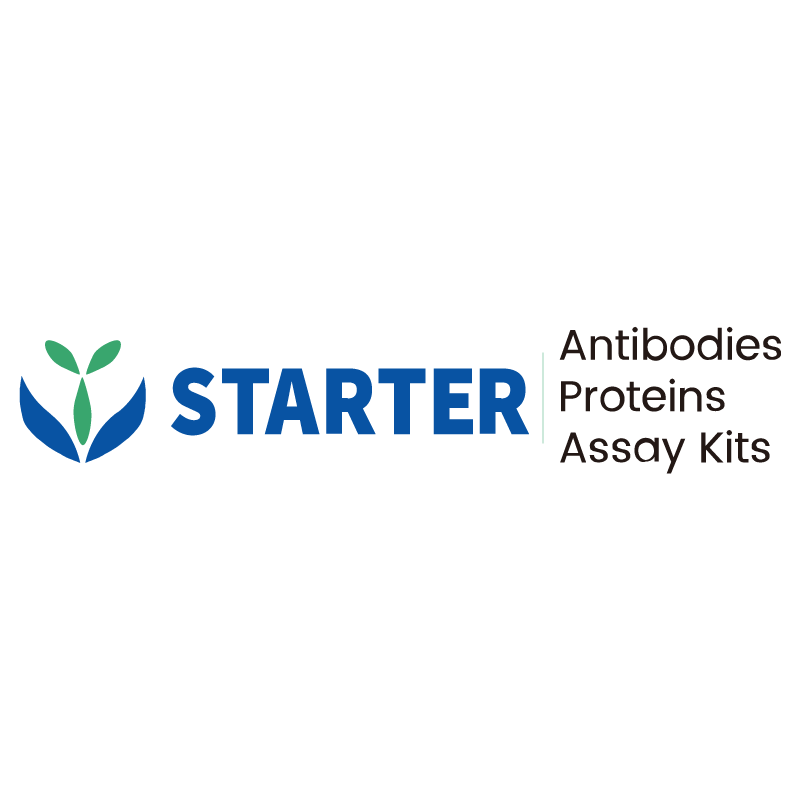WB result of Calbindin Recombinant Rabbit mAb
Primary antibody: Calbindin Recombinant Rabbit mAb at 1/1000 dilution
Lane 1: mouse spleen lysate 20 µg
Lane 2: mouse brain lysate 20 µg
Lane 3: mouse cerebellum lysate 20 µg
Negative control: mouse spleen lysate
Secondary antibody: Goat Anti-Rabbit IgG, (H+L), HRP conjugated at 1/10000 dilution Predicted MW: 30 kDa
Observed MW: 25 kDa
Product Details
Product Details
Product Specification
| Host | Rabbit |
| Antigen | Calbindin |
| Synonyms | Calbindin D28; D-28K; Vitamin D-dependent calcium-binding protein, avian-type; CALB1; CAB27 |
| Immunogen | Synthetic Peptide |
| Location | Cytosol |
| Accession | P05937 |
| Clone Number | S-774-378 |
| Antibody Type | Recombinant mAb |
| Isotype | IgG |
| Application | WB, IHC-P, IF |
| Reactivity | Hu, Ms, Rt |
| Positive Sample | mouse brain, mouse cerebellum, rat brain, rat cerebellum |
| Predicted Reactivity | Bv, Or |
| Purification | Protein A |
| Concentration | 0.5 mg/ml |
| Conjugation | Unconjugated |
| Physical Appearance | Liquid |
| Storage Buffer | PBS, 40% Glycerol, 0.05% BSA, 0.03% Proclin 300 |
| Stability & Storage | 12 months from date of receipt / reconstitution, -20 °C as supplied |
Dilution
| application | dilution | species |
| WB | 1:1000 | Ms, Rt |
| IHC-P | 1:1000 | Hu, Ms, Rt |
| IF | 1:2000 | Hu |
Background
Calbindin is a calcium-binding protein that plays a significant role in various biological processes. It serves as a calcium-buffering protein that maintains intracellular calcium homeostasis and modulates calcium influx. It is involved in protection against apoptotic cell death by buffering calcium and by inhibiting caspase-3. Calbindin is also implicated in the cytoplasmic transport of calcium and is sometimes referred to as a calcium-binding protein. In the context of Alzheimer's disease, calbindin plays a role in maintaining calcium homeostasis, which is crucial for preventing neurodegeneration. High calcium levels in the hippocampus and cortex, which can result from amyloid beta accumulation and phosphorylated tau tangles, can lead to neuronal damage. Calbindin helps to buffer these high calcium levels, thus protecting neurons.
Picture
Picture
Western Blot
WB result of Calbindin Recombinant Rabbit mAb
Primary antibody: Calbindin Recombinant Rabbit mAb at 1/1000 dilution
Lane 1: rat spleen lysate 20 µg
Lane 2: rat brain lysate 20 µg
Lane 3: rat cerebellum lysate 20 µg
Negative control: rat spleen lysate
Secondary antibody: Goat Anti-Rabbit IgG, (H+L), HRP conjugated at 1/10000 dilution Predicted MW: 30 kDa
Observed MW: 25 kDa
Immunohistochemistry
IHC shows positive staining in paraffin-embedded human cerebellum. Anti-Calbindin antibody was used at 1/1000 dilution, followed by a HRP Polymer for Mouse & Rabbit IgG (ready to use). Counterstained with hematoxylin. Heat mediated antigen retrieval with Tris/EDTA buffer pH9.0 was performed before commencing with IHC staining protocol.
IHC shows positive staining in paraffin-embedded human cerebral cortex. Anti-Calbindin antibody was used at 1/1000 dilution, followed by a HRP Polymer for Mouse & Rabbit IgG (ready to use). Counterstained with hematoxylin. Heat mediated antigen retrieval with Tris/EDTA buffer pH9.0 was performed before commencing with IHC staining protocol.
IHC shows positive staining in paraffin-embedded human kidney. Anti-Calbindin antibody was used at 1/1000 dilution, followed by a HRP Polymer for Mouse & Rabbit IgG (ready to use). Counterstained with hematoxylin. Heat mediated antigen retrieval with Tris/EDTA buffer pH9.0 was performed before commencing with IHC staining protocol.
IHC shows positive staining in paraffin-embedded human tonsil. Anti-Calbindin antibody was used at 1/1000 dilution, followed by a HRP Polymer for Mouse & Rabbit IgG (ready to use). Counterstained with hematoxylin. Heat mediated antigen retrieval with Tris/EDTA buffer pH9.0 was performed before commencing with IHC staining protocol.
Negative control: IHC shows negative staining in paraffin-embedded human liver. Anti-Calbindin antibody was used at 1/1000 dilution, followed by a HRP Polymer for Mouse & Rabbit IgG (ready to use). Counterstained with hematoxylin. Heat mediated antigen retrieval with Tris/EDTA buffer pH9.0 was performed before commencing with IHC staining protocol.
IHC shows positive staining in paraffin-embedded mouse cerebellum. Anti-Calbindin antibody was used at 1/1000 dilution, followed by a HRP Polymer for Mouse & Rabbit IgG (ready to use). Counterstained with hematoxylin. Heat mediated antigen retrieval with Tris/EDTA buffer pH9.0 was performed before commencing with IHC staining protocol.
IHC shows positive staining in paraffin-embedded rat cerebellum. Anti-Calbindin antibody was used at 1/1000 dilution, followed by a HRP Polymer for Mouse & Rabbit IgG (ready to use). Counterstained with hematoxylin. Heat mediated antigen retrieval with Tris/EDTA buffer pH9.0 was performed before commencing with IHC staining protocol.
Immunofluorescence
IF shows positive staining in paraffin-embedded human cerebellum. Anti-Calbindin antibody was used at 1/2000 dilution (Green) and incubated overnight at 4°C. Goat polyclonal Antibody to Rabbit IgG - H&L (Alexa Fluor® 488) was used as secondary antibody at 1/1000 dilution. Counterstained with DAPI (Blue). Heat mediated antigen retrieval with EDTA buffer pH9.0 was performed before commencing with IF staining protocol.


